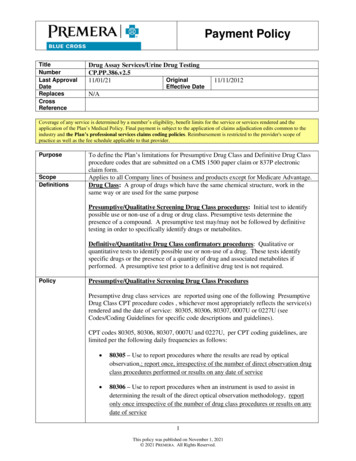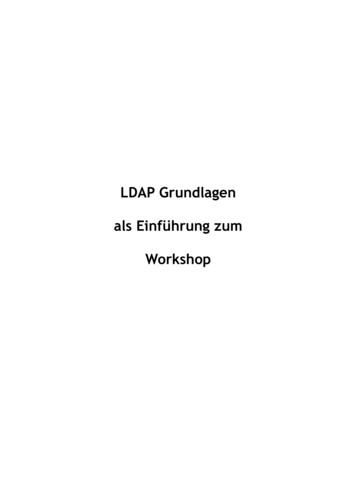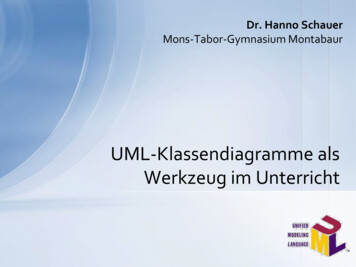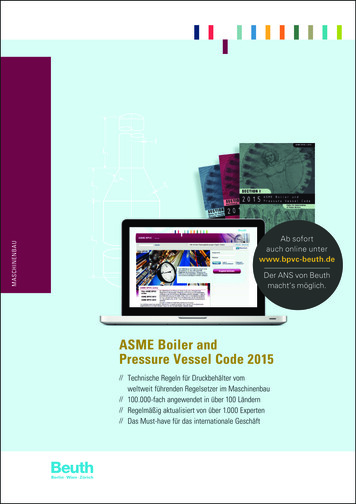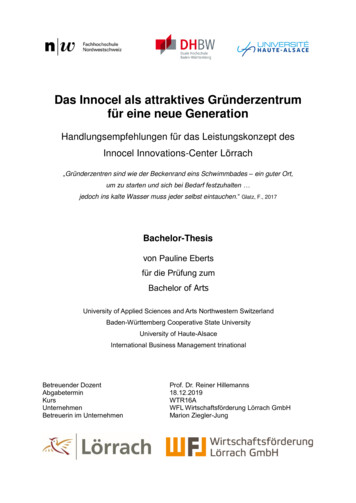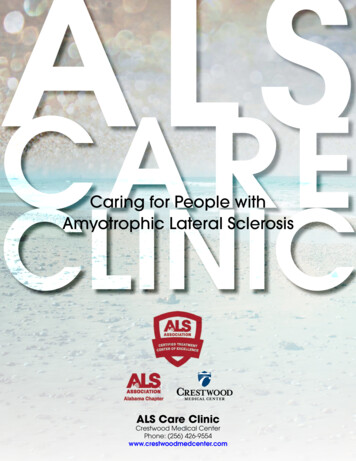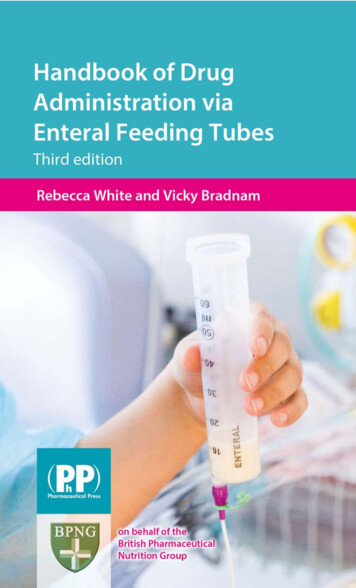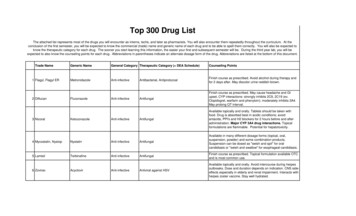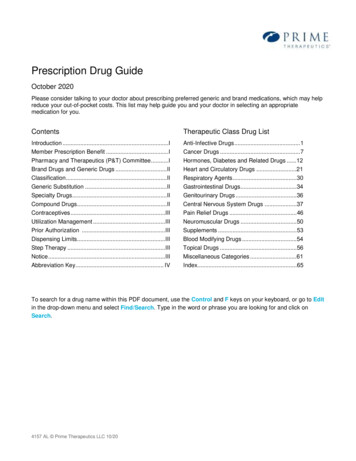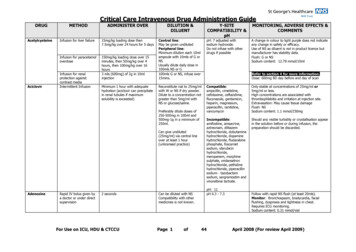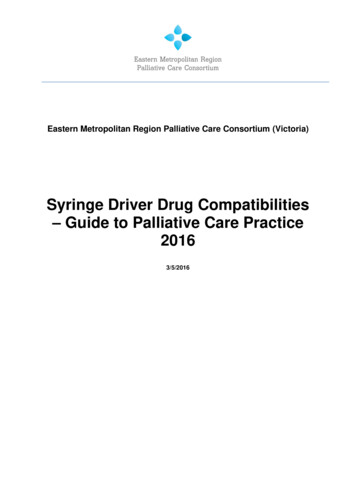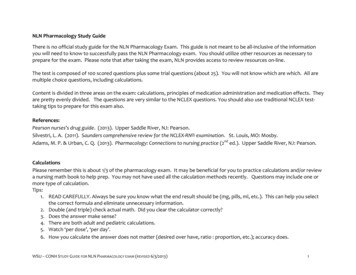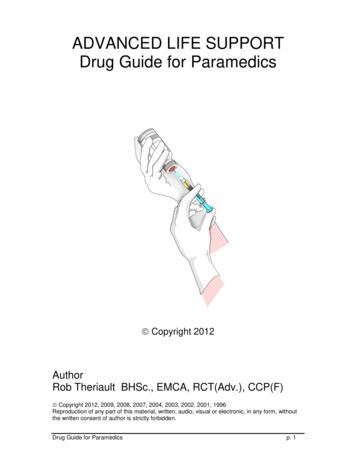
Transcription
ADVANCED LIFE SUPPORTDrug Guide for Paramedics Copyright 2012AuthorRob Theriault BHSc., EMCA, RCT(Adv.), CCP(F) Copyright 2012, 2009, 2008, 2007, 2004, 2003, 2002, 2001, 1996Reproduction of any part of this material, written, audio, visual or electronic, in any form, withoutthe written consent of author is strictly forbidden.Drug Guide for Paramedicsp. 1
Table of ContentThe following guide provides a description of drugs for Primary and AdvancedCare Paramedics in the field.Page“Seven Rights” of drug administration . 3Adenosine . 4Amiodarone . 6Aspirin . 8Atropine . 10D50W . 12Diazepam . 14Dimenhydrinate . 16Diphenhydramine . 18Dopamine . 20Epinephrine IV, SC . 22Fentanyl . 24Furosemide . 26Glucagon . 28Lidocaine . 30Midazolam . 32Morphine . 34Naloxone . 36Nitroglycerin . 38Oxygen . 40Salbutamol (Ventolin) . 42Sodium Bicarbonate . 44Xylometazoline HCL (Otrivin) . 46Medicine and pharmacology is a constantly changing science and not all therapies are clearlyestablished. New research changes drug and treatment therapies daily. The author and publisherof this document have has used his best efforts to provide information that is up-to-date andaccurate and is generally accepted within medical standards at the time of publication. However,as medical science is constantly changing and human error is always possible, the author andpublisher does not warrant that the information in this document is accurate or complete, nor isthe author responsible for omissions or errors in the document or for the results of using thisinformation. The reader should confirm the information in this document from other sources priorto use. In particular, all drug doses, indications, and contraindications should be confirmed. Inaddition, the drug indications and dosages described in this guide are based on general guidelinesand principles of drug administration and do not replace or supersede your Medical Directives orStanding Orders.For additional continuing medical education resources visit Paramedic Tutor at:http://paramedictutor.wordpress.com/Drug Guide for Paramedicsp. 2
Seven “Rights” of Drug Administration1. Right Patient? Is this patient right for this drug? Is this drug contraindicated because of medical history, allergies, druginteraction, presenting condition, heart rate, blood pressure, mentalstatus, etc?2. Right Drug? some drugs come is similar ampoules, vials or nebules (e.g. epinephrineand morphine, naloxone and midazolam ) – always check the drug whenyou pull it out of the kit for the name, dose, concentration and for fluidclarity and expiry date. Check the drug again before administering it. syringes with left over medication must be labelled with the drug nameand concentration per ml. A narcotic should be checked by two people prior to administration(except when alone in the back of the ambulance)3. Right Dose? double check dosage calculation - have partner do the same whenpractical Is your estimation of the patient’s weight reasonable? The Broselow tape is recommended for weight estimation in paediatrics4. Right Time? Follow dosing intervals listed in Medical Directives. Remember that repeated doses of a drug may have an added effect. Timing may be critical to maintain a therapeutic drug level5. Right Route? Which route is most appropriate for this patient – e.g. SC, IM or IV. In the case of anaphylaxis for example, SC may be acceptable in the earlystages, however, once shock has set in, the IM route is better.6. Right to know? patient has a right to be informed about the drug; What the drug is andwhat it does; benefits and risks; a right to sound medical advice7. Right to refuse You must obtain permission from the patient for any intervention The patient has the right to refuse treatment at any time e.g. it’s not uncommon for patients to refuse ASA for various reasons e.g. some patients will refuse Adenosine because it causes them greatphysical distress or they know it hasn’t worked for them in the past. Assess patient’s “capacity” in the event of a refusal and use the BaseHosp. Physician and/or supervisor for assistanceDrug Guide for Paramedicsp. 3
Adenosine (Adenocard)Classification: antiarrhythmicPharmacodynamics: naturally occurring nucleoside that stimulates specificadenosine receptors. This results in activation ofacetylcholine sensitive potassium channels (efflux ofpotassium) and blockade of calcium influx in the SA node,atrium and AV node. The cells become hyperpolarized andthis blunts SA node discharge, slows AV conduction andincreases the AV node refractory period. AV nodalconduction may be completely blocked.interrupts AV nodal re-entry and other AV node dependanttachyarrhythmias TION 20-30 secondsunknown6-10 seconds1-2 minutesIndications: conversion of supraventricular tachycardia (SVT) /paroxysmal supraventricular tachycardia (PSVT) includingthat associated with Wolff-Parkinson-White syndromeContraindications: hypersensitivity, 2nd or 3rd degree AV block, sick sinussyndromePrecautions: may worsen bronchospasm in asthmatics and some patientswith COPDflushing and chest pain may occur briefly afteradministration. drug to drug: Adverse effects Drug Guide for Paramedicshigher than normal doses of Adenosine may be required forpatients on xanthines (eg. theophylline).lower than normal doses (i.e. 3 mg or less) should be usedfor patients on dipyridamole (Persantine ) as this drugpotentiates Adenosine.the effects of Adenosine are prolonged in patients takingCarbamazepine (anti-convulsant) and in heart transplantrecipients (denervated hearts)crushing chest pain, flushing, SOB, N/V, lightheadedness,dizziness, syncope, etcexplain to the patient they will likely experience some of theabove symptomsp. 4
Dosage: 6 mg IV bolus (FAST!) -followed by an immediate 20-30 ccof NS or R/L flush - run ECG strip as drug is being given12 mg IV bolus (FAST!) -followed by an immediate 20-30 ccof NS or R/L flush - may be repeated in 1-2 minutes if thefirst dose is ineffective.Note: Adenosine must be given very quickly and in the IV siteclosest to the central circulation (e.g. antecubital, externaljugular, central line). It should always be immediatelyfollowed by a 20-30 cc flush of NS or R/L to make sure thatall of the drug is cleared from the IV tubing and delivered tothe intended sitePediatric 0.1 - 0.2 mg/kg rapid push (flush with 2-20 cc IV fluiddepending weight of child)SPECIAL NOTES: has a 90% successful conversion of PSVT rate when thefull dose is given (Crankin et al, 1989; Garrat et al, 1989;DiMarco et al, 1990)has an extremely short half life of 10 seconds or less –consequently, as many as 40% of patients may revert backinto PSVTOnce the drug is given, the patient may be experience aperiod of asystole of 3-15 seconds. A variety of otherrhythms may also appear on the ECG ( e.g. second or thirddegree heart block). Because of the drug's short half life,these effects are generally self-limitingSometimes rapid Atrial Fibrillation is difficult to distinguishfrom a regular SVT. If that occurs turn the volume up on thecardiac monitor. This will provide an auditory clue that therhythm is irregularly irregular. Map out the R-R interval to seeif the rhythm is regular (SVT) or irregular (A. Fib.). Use thepatient’s history and medications as a guide – i.e. the elderlypatient on digoxin and coumadin is more likely to be in anatrial fib. The younger patient is more likely to be in an SVT.Transport of the patient should not be delayed as othertreatments/drugs may be required in hospital shouldSVT/PSVT recur Drug Guide for Paramedicsp. 5
Amiodarone Classification:Pharmacodynamics: antiarrhythmicconsidered a class III antiarrhythmicalso possesses electrophysiologic characteristics of all 4Vaughan Williams classesLike Class I drugs, amiodarone blocks sodium channels atrapid pacing frequencieslike class II drugs, it exerts sympatholytic activity throughbeta-adrenoreceptor (weak) antagonismClass II type effects negative chronotropic effect in nodaltissuesclass III effect: lengthens the cardiac action potential –prolongs the QT intervalIn addition to blocking sodium channels, amiodarone blocksmyocardial potassium channels, which contributes to slowingof conduction and prolongation of refractorinessantisympathetic action and block of calcium and potassiumchannels are responsible for the negative dromotropic effectson the sinus node and for the slowing of conduction andprolongation of refractoriness in the atrioventricular ON ? minutes10-15 minutes?Indications: ventricular fibrillationventricular tachycardiaSVTatrial fibrillationContraindications: HypersensitivityCardiogenic shockMarked sinus bradycardia2nd or 3rd degree AV blockPrecautions: Poor liver functionWarning Hypotension of the most common side effect during IVinfusion ( 39% of patients in one trial) Slow the infusion.Thyroid dysfunction – may cause hypo or hyperthyroidism(negligible for IV administration) Drug Guide for Paramedicsp. 6
Drug to druginteractions Pulmonary interstitial abnormalities (1/1 000 patients treatedwith amiodarone i.v. in clinical studies developed pulmonaryfibrosis)May cause prolongation of the QT interval ( 500ms may leadto Torsade de Pointes)Amiodarone interacts with numerous other drugs, howeverthese effects may be more relevant to oral administration insome casesrisk of life-threatening cardiac arrhythmias, includingtorsades de pointes, may be increased in a patient takingVardenafilAmiodarone may increase serum concentrations ofdisopyramide, flecainide, procainamide, quinidineMay potentiate the effects of warfarin, Dabigatran, betablockers, calcium channel blockers (eg, diltiazem,verapamil), Digoxin, Clozapine, Cyclosporine,Dextromethorphan, Fentanyl, Fingolimod, loratadine,trazodoneMay cause QTc prolongation with or without torsades depointes when combined with Azole antifungals (eg,itraconazole), fluoroquinolones (eg, moxifloxacin), macrolideantibiotics (eg, azithromycin, telithromycin),Quinupristin/DalfopristinCimetidine and protease inhibitors (e.g. ritonavir) mayincrease the plasma concentrations of AmiodaroneMay diminish the effects of ClopidogrelEffects of amiodarone may be reduced by the concomitantuse of CholestyramineDosage: 150-300mg loading dosePediatric 5mg/kg in cardiac arrestSpecial Notes: if the patient becomes hypotensive or bradycardic during theinfusion of amiodarone, slow down the infusion ordiscontinueDrug Guide for Paramedicsp. 7
Aspirin (ASA)Classification: antiplateletantithromboticaspirin also falls under many other functional classificationsPharmacodynamics: inhibits the formation of thromboxane A2 which is a potentplatelet aggregate and vasoconstrictorONSETPEAKHALF-LIFEDURATION 15-30 minutes1-2 hours2-3 hours (low dose)4-6 hoursIndications: chest pain or atypical symptoms consistent with cardiacischemia/AMIContraindications: allergy to aspirin or other non-steroidal anti-inflammatory(NSAIDS) agents. This includes many non-aspirin/nonTylenol pain relievers such as Advilasthmarecent head injury, stroke or acute bleeding (significant) ofany kindPharmacokinetics: Precautions: recent internal bleeding (within last 3 months)known bleeding diseasespatients currently taking anticoagulant agent(s)recent surgerypossibility of pregnancyDosage: 160 - 325 mgHave the patient chew ASA before swallowingPediatric noneSpecial Notes: As an antithrombotic, ASA helps to limit the size of theinfarction. It does not reduce the size of the infarction asthrombolytics do.higher doses of aspirin ( 325 mg) may suppress theproduction of prostacyclin which is a prostaglandin withantiplatelet and vasodilatory properties. Therefore, higherdoses of aspirin counteract the beneficial affect of the lowerdoses. Drug Guide for Paramedicsp. 8
Drug Guide for Paramedicsp. 9
AtropineClassification: anticholinergicantimuscurinicPharmacodynamics: parasympatholytic (inhibits stimulation from theparasympathetic nervou
Drug Guide for Paramedics p. 7 Pulmonary interstitial abnormalities (1/1 000 patients treated with amiodarone i.v. in clinical studies developed pulmonary fibrosis) May cause prolongation of the QT interval ( 500ms may lead to Torsade de Pointes) Drug to drug .File Size: 631KBPage Count: 47
